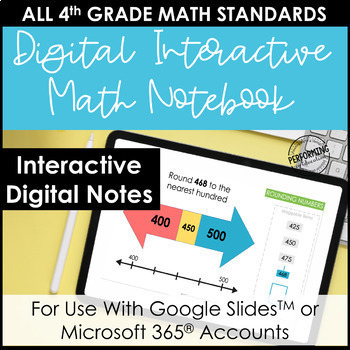Digital Interactive Notebook for 4th Grade Math | Entire Year of Math Lessons!
- Google Drive™ folder

What educators are saying
Also included in
- This multi-grade digital interactive math notebook can be used to interactively teach your standards in Google and Microsoft! You'll get the full drive with lessons organized by standard for 3rd, 4th, 5th, and 6th grade. Each lesson comes with moveable pieces to provide a visual model for students aPrice $59.00Original Price $100.00Save $41.00
Description
This 4th grade digital interactive math notebook can be used to interactively teach your standards in Google and Microsoft! You'll get the full drive with lessons organized by standard. Each lesson comes with moveable pieces to provide a visual model for students as they are learning the new standard.
Watch a video preview of one of the units.
Included in this resource:
- Interactive notes for all math standards (with interactive math pieces - this is not simply a paper product with text box overlay!)
- A teacher answer key to show you how to walk students through each model
- Tutorial videos to help you use the resource in Google & Microsoft
- Email support for if you need help implementing these lessons
This resource provides interactive notes for all 4th grade math standards!
Geometry Notebook
4.G.A.1 Points, lines, line segments, rays, angles, and perpendicular and parallel lines in two-dimensional figures.
4.G.A.2 Classify two-dimensional figures
4.G.A.3 Recognize a line of symmetry
Operations & Algebraic Thinking
4.OA.A.1 Multiplicative comparisons
4.OA.A.2 Multiplicative comparison word problems w/equations
4.OA.A.3 Multi-step word problems
4.OA.B.4 Factors, Multiples, Prime & Composite numbers
4.OA.C.5 Generate and analyze patterns
Numbers in Base Ten
4.NBT.A.1 Place value with whole numbers
4.NBT.A.2 Writing and comparing multi-digit whole numbers
4.NBT.A.3 Rounding whole numbers
4.NBT.B.4 Adding and subtracting multi-digit whole numbers
4.NBT.B.5 Multiplying multi-digit numbers
4.NBT.B.6 Dividing multi-digit numbers
Fractions
4.NF.A.1 Equivalent Fractions
4.NF.a.2 Comparing Fractions
4.NF.B.3 Adding & Subtracting Fractions
4.NF.B.4 Multiplying Fractions
4.NF.C.5 Adding Tenths and Hundredths
4.NF.C.6 Decimal Notation
4.NF.C.7 Comparing Decimals
Measurement and Data
4.MD.A.1 Measurement Conversion
4.MD.A.2 Solving Measurement Word Problems
4.MD.A.3 Area and Perimeter
4.MD.B.4 Measuring Fractions Using Line Plots
4.MD.C5 Types of Angles
4.MD.C6 Measuring Angles
4.MD.C7 Unknown Angles
*****************************************************************************
Customer Tips:
How to get TPT credit to use on future purchases:
• Please go to your My Purchases page after you log in. Beside each purchase see a Provide Feedback button. Simply click it and you will be taken to a page where you can give a quick rating and leave a short comment for the product. Each time you give feedback, TPT gives you feedback credits that you use to lower the cost of your future purchases. I value your feedback greatly as it helps me determine which products are most valuable for your classroom so I can create more for you.
Be the first to know about my new discounts, freebies and products:
• Look for the green star next to my store logo and click it to become a follower.
*****************************************************************************






